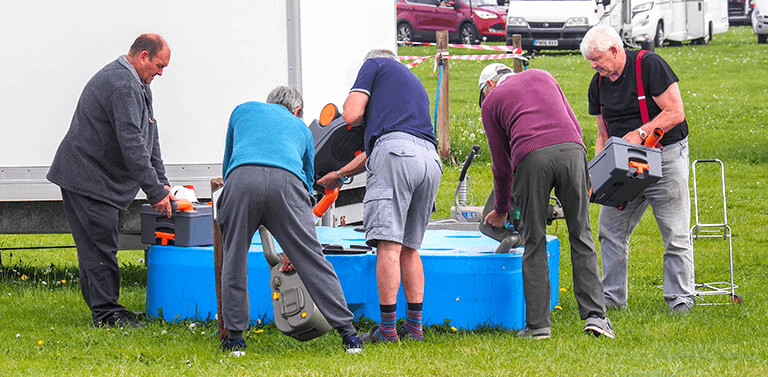Black Waste is the name given to all the nasty things that go into your motorehome toilet. Just a few years ago the most common method for dealing with toilet waste was colloquially known as “Bucket and chuck it” (as used in some of her Majesty’s prisons to this day.)
Bucket and Chuck-it
This simple bucket system is still used by some “day campers” (day campers are small like VW camper vans with no bathroom.) However, most campers by now have progressed to the Porta-Potti which is still a form of Bucket and Chuck it, but more comfortable. It comes in two parts. The upper section has a comfy seat above a combined flush-water tank and toilet bowl. The lower section is the waste holding tank. When it’s full, you detach the bottom half. You still “chuck it” but conveniently, with a lot less chance of spilling some onto your flip flops, which is a common occurrence when carrying a full bucket.
These buckets and porta-potties were often used in a small toilet tent or inside the motorhome, probably sat in the kitchen! You can imagine that this was not ideal. This all changed for the better with modern chemical toilets, known in the UK as the Elsan.
What is an Elsan Cassette?
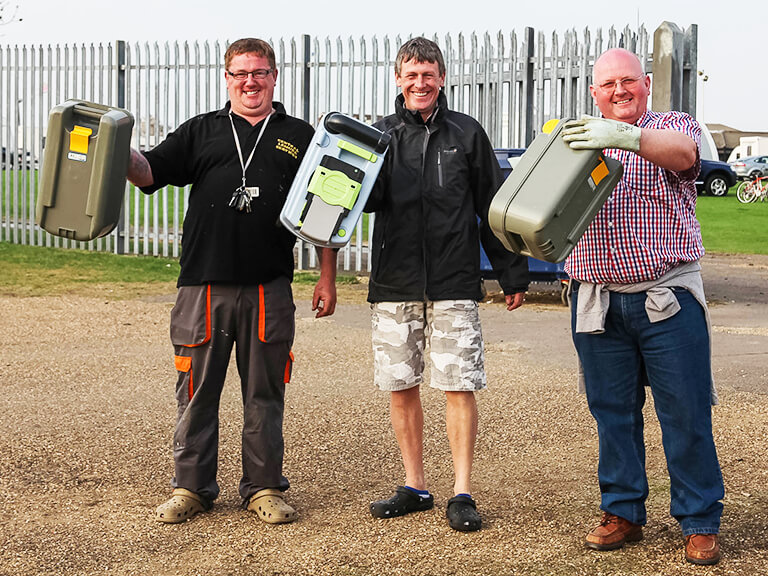
Most motorhomes now come with built-in toilets in their washrooms. These toilets are generally made by either Thetford or Dometic. They use a cassette waste holding tank, often still called an Elsan in the UK.
The modern motorhome toilet has two big advantages over the bucket, firstly you are unlikely to have to do your business in the kitchen, as all but the smallest vans have a dedicated bathroom, and you won’t be carrying it through the kitchen to empty it as the cassette can be removed from the outside of the motorhome.
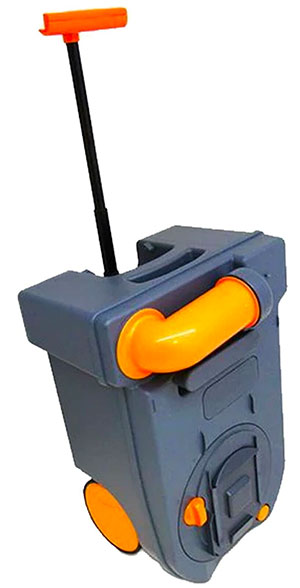
The vast majority of motorhomes in Europe use a cassette rather than a holding tank. The cassette slides out from under the seat from outside the van. Most cassettes have a capacity of around 18 L or just under 4 gallons and are heavy; once full they can be a job to carry. (pun intended)
Recognising that some people struggle with a full cassette; some models of cassette now incorporate wheels and a slide out handle, much like carry-on airline flight bags.
This means you can briskly walk to the Elsan dump point like an executive might stroll through an airport. Not that a customs officer would want to search through this particular luggage!
How long before the cassette gets full?
At first, not long at all. People used to modern loo systems at home; who like to have 4 inches of water to drop things into, will soon need to be emptied. Most modern loos have a traffic light system to show when they are empty or full.
With prudent use and not using too much water to flush, a single full-time motorhomer might go a whole week between empties. In contrast, when our kids were young and there were five in the van, it was not uncommon to empty twice a day!
If you are in a campsite, then emptying twice a day isn’t really a problem, just an inconvenience. However, if you are wild camping; then finding somewhere to dump a full cassette might be more difficult. Which is why many wild campers carry an extra cassette. A couple in a motorhome with a spare cassette can easily go 7 to 10 days without having to empty.
You wouldn’t want to store a full cassette under your kitchen sink. Ideally, this storage would be outside. There are brackets you can buy that affix under your van so you can slide the cassette in and it will remain safe until you can find somewhere to dump it responsibly.
The Marine Toilet
Rather than filling a small cassette which needs emptying every day or every other day, some motorhomes have a larger holding tank, much like boats do, hence the name marine toilet.
Popular with full-timers, a marine toilet can hold anywhere between 15 and 100 gallons. Most would baulk at carrying that much waste around with them, but they vent these large tanks via a small flue direct from the tank to the roof and smells are no more wince-inducing than smaller capacity cassette toilets.
You empty Marine toilets quickly and effectively via a pipe and gravity, or if you can’t get the motorhome to the dump point, you can empty a few gallons at a time and we’re back to bucket and chuck it. Marine toilets really are the best of both worlds, being able to go a longer between empties, and if there are not the facilities to easily dump the tank, you can empty it a few gallons at a time into a Fiamma tote, just like a regular cassette user might.
Macerators
Marine toilets can also be emptied with a macerator. Think of it as a regular pump but with a fast food blender blade cutting everything up before pumping it into a small diameter hose that can carry the waste up to 100m away to the Elsan Point. Macerators are popular with owners of large American RVs as their vehicles are often too large to access the dump point. Macerators are great until they go wrong, and they will.
Most macerator owners can tell stories of emptying the hose after the macerator pump stops. Imagine squeezing the last bit of toothpaste from the tube, but it’s not toothpaste you are squeezing, and the tube is 30m long! That is nearly as much fun as dismantling the macerator to see what stopped it spinning!
Toilet Chemicals
There are many toilet chemicals designed to do one thing, and that is make the contents of your cassette smell sweeter, though I’m sure for some of us the chemical that can do this is yet to be invented.
Just a few years ago, most of these were formaldehyde-based. On the forums, there were plenty of discussions about which smelled the worse, the waste or the formaldehyde. Formaldehyde is still widely used but is best avoided.
These products make various claims, killing germs, breaking down waste, but most people buy them to mask the smell. These products are not cheap and can add a couple of hundred pounds a year to your motoring bills.
These days though, there is a lot more choice; all the manufacturers are now making green versions of the product. Which is good for the planet’s health and your own.
Formaldehyde fumes at the right concentration are very dangerous to humans; so, sat in the smallest room in your motorhome on a hot day with plenty of formaldehyde is not really a good idea. Do try to choose a formaldehyde free chemical. Or do as we have for many years, do not use any chemicals at all.
In my experience, cassette contents stink, and it doesn’t matter whether you’ve put chemicals in them or not. When you empty them, they smell. The chemicals might promise to break down waste, but if you like me have three kids and a partner, then no matter what chemicals you use, the waste is never in the cassette long enough to breakdown.
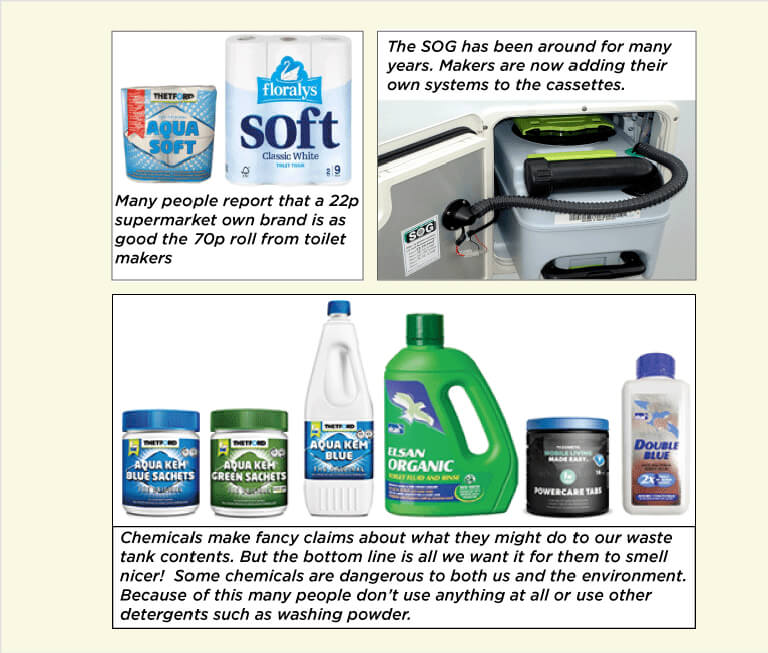
Septic tanks
Many CLs in the countryside use septic tanks for their waste. They won’t thank you for emptying 3 gallons of formaldehyde blue into the waste point. It will ruin their toilet system, which might cost a small fortune to fix; So if you use the UK’s excellent CL network then get used to not using blue chemicals or at least carry one of the septic tank friendly green chemicals just in case you come across sites that ban the blue stuff.
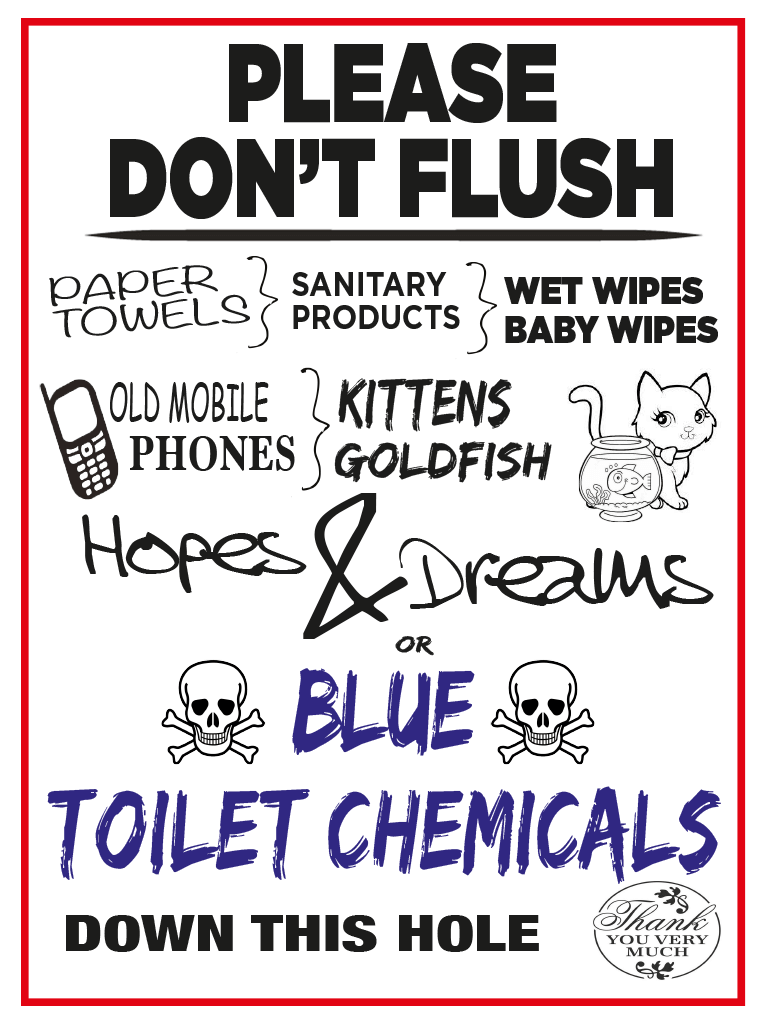
Toilet paper
If money is no object, you can buy the special motorhome toilet paper you find in motorhome accessory shops made by the same people who make the chemicals. They market this paper in such a way that you feel you need to use it. The packaging will say it dissolves quickly and easily and prevents clogging making your waste tank easier to empty ect.
The fact is, most toilet paper you buy from the supermarket will do exactly the same job. You don’t want to be using the very expensive triple ply cushioned stuff, rather the cheaper own brand paper will dissolve quickly and at a fraction of the cost of the named stuff.
Plastic Vs Porcelain Bowls
You should know that plastic toilets found in most medium budget motorhomes are not quite as ‘slippy’ as superior ceramic ones; this coupled with small toilet dimensions means people without a good aim need to be good with a brush.
The Super Sog
The SOG is an after market extractor fan designed for the cassette motorhomne toilet that means you can open your loo blade, sit down and make your deposit direct to the tank. Smells don’t make it out as they are sucked outside the van, often straight into a neighbour’s awning SOG users swear by them, neighbours might swear at them, but they are effective and reduce the need for smelly dangerous chemicals.
No 2’s
Some people never use their motorhome loo for No 2’s. For reasons known only to them, they prefer to find a warm seat in the campsite facilities!
Motorhome loos and the use of them is a very popular forum topic. and we’ve learned over the years the many ways that people use their toilets. I’ll try to condense some common methods into a few paragraphs. You’ll appreciate that essentially, whatever method, The aim is to deposit the goods into the cassette with as little fuss, drama and aroma as possible.
Four ways to fill your Elsan
1. Just like at Home
Some people use their motorhome toilet just like they do at home. They like to get to 4 inches of water at the bottom of the bowl. This has pros and cons. The good thing, anything you drop into the bowl is immediately covered by the water so you get no smells. The bad is that using this method you will fill your tank quickly, mostly with water. Close the lid before you flush. You are about to drop two pints of waste into your tank. This means that 2 pints of smelly air needs to escape. Closing the lid when you flush can help stop the smells permeate the whole van.
2. Open and Shut Case
Some people like to open the blade at the very last moment and use learned skills, without touching the side, to plop everything neatly through the hole straight into the tank, then quickly close the blade. This uses much less water and if you are a very good aim, little to no flush.
3. Catch it and wrap it
This method suits those whose aim is poor. You need two or three equal lengths of toilet tissue just over a foot long. Hold an end of the paper in each hand drop the centre into the bowl, leaving the ends to line the rim, crisscrossing the tissue to make a four or six-petaled flower, lining all the bowl. Now carefully open the valve and the tissue will hopefully ensure not too much aroma of yesterday will enter the room. Aiming for the centre of the flower. Hit the mark and your deposit will be neatly wrapped and deposited into the tank, leaving no marks on your porcelain. Quickly close the valve.
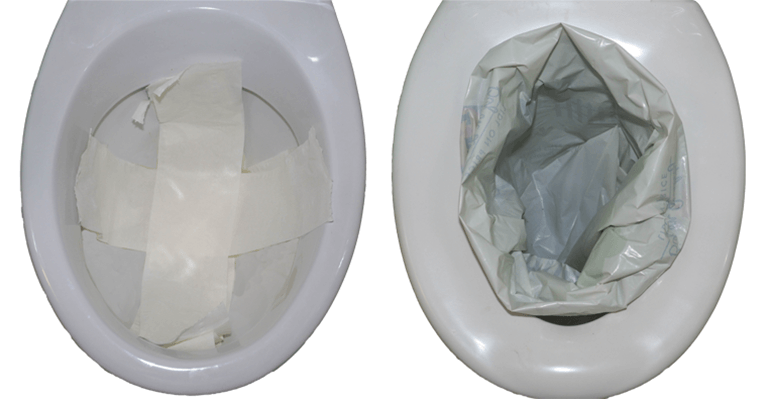
4. The motorhome toilet “Bag and Dump“
Some freeloaders who camp for a long time in places with no facilities to dump the tanks use this method. They don’t want to fill their motorhome toilet tank at all, so they line it with a plastic shopping bag, dump in that, and then dump the bag in a litter bin!
Flushing
Some motorhome toilet systems have a separate flush tank that holds a sweet smelling chemical flush. Others use water direct from your fresh water tank. It’s common for those with a freshwater flush to have some flush chemical in a spray bottle to keep things spelling nice. Talking of sprays, some people use silicone spray to keep the sides of the loo as slippy as possible so as not to use a brush or too much flush. The silicone spray keeps the valve in good condition, too.
Emptying the Cassette
Most system have a light to let you know they are full. It’s a good idea to let everyone know when you are emptying, otherwise you might find the compartment a bit mess when you return. This is especially so if you have young kids with you.
Most motorhomers in the game for a decade or more will have lost a tank cap at least once, and often in a place they’d rather not fish for it. Don’t worry, this is so commonplace, most accessory suppliers carry spares. But get into the habit of placing the cap where it can’t fall into a hole you wouldn’t want to put your hand in.
Avoiding Splashback
The second most important thing about emptying the motorhome toilet is avoiding the dreaded splashback, it takes a while to learn the special nuances of different dump points. Until you are an expert, like Jock in the picture; wear long gloves and keep your mouth closed!
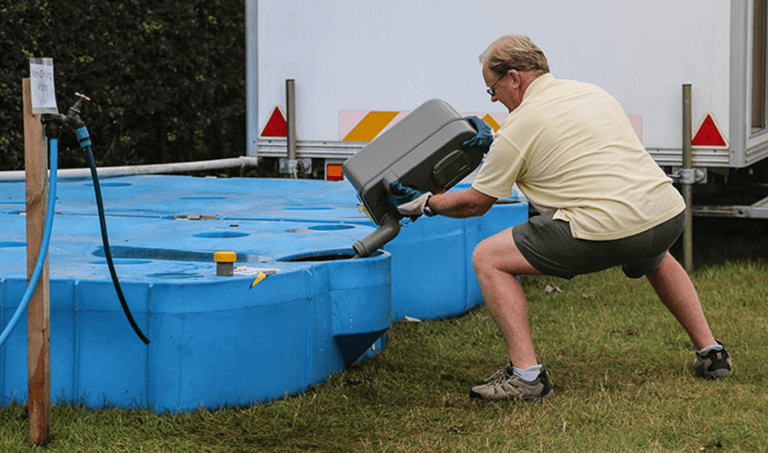
Motorhome Toilet Disposal (Elsan Point)
Disposal points vary a lot, from custom-made systems of shiny stainless steel to an upturned traffic cone acting as a funnel to an open sewer pipe. When emptying your cassette, only two things should concern you. The first and most important is ensuring that this is the right place for black water dumping. When abroad, it can be a little confusing as to which is the black water waste point, if in doubt, always ask.
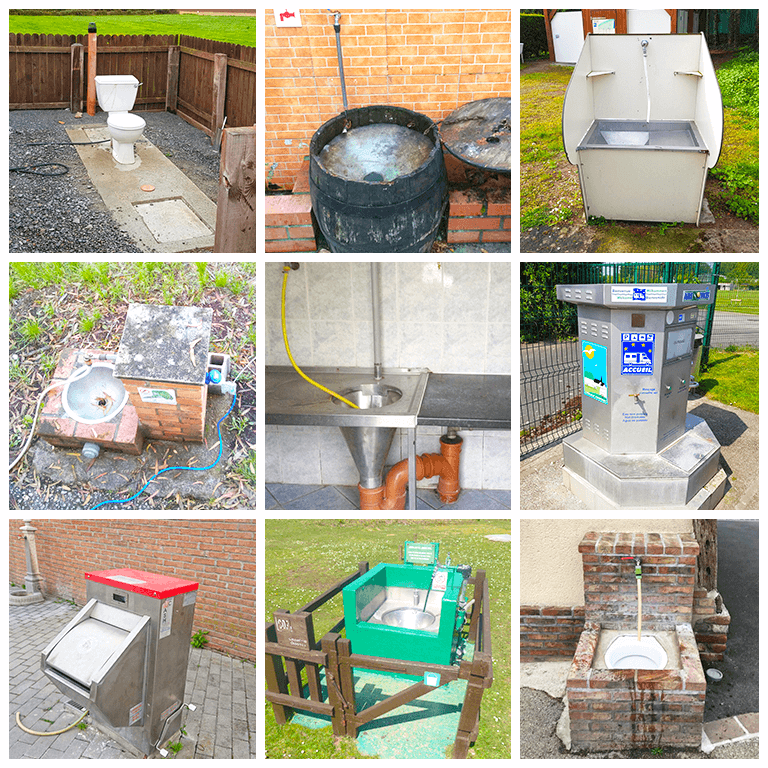
Toilets and Wildcamping
Some wild campers will take their cassette into public toilets, normally hidden in a small rucksack used specifically for this purpose.
It’s a good idea to carry a small clean up kit of wipes or disinfectant in the rucksack just in case of mishaps. If you use this method, try to find deserted toilets.
I recall very early one-morning in the delightful city of Chichester I was emptying a cassette into a public toilet. Unbeknown to me, there was an old tramp trying to sleep in the next cubicle, as my four gallons spladooshed, dooshed and plopped noisily into the bowl; the tramp in horror asked if I was OK.
Always a popular topic there are 100’s of motorhome toilet discussions on our forums

